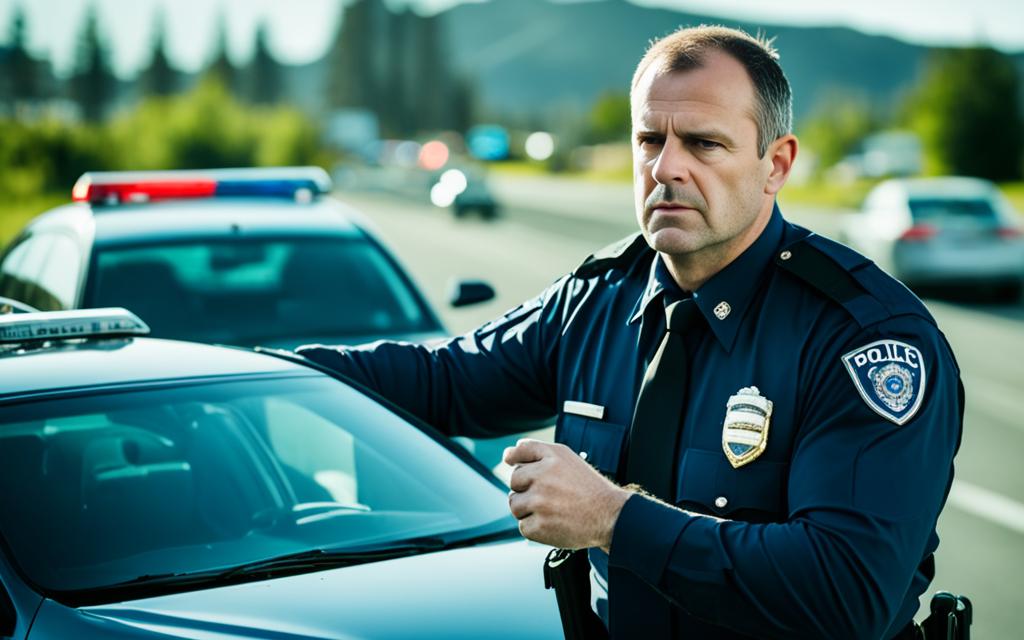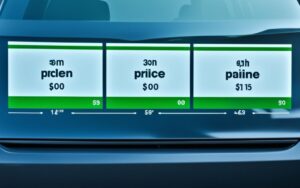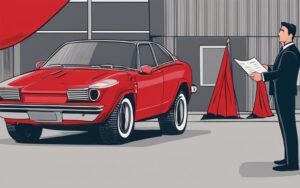Why Do Cops Touch Your Car? Unveiling Facts
One reason why cops touch your car is to ensure their own safety during a traffic stop. Police officers follow specific procedures and safety measures to protect themselves and the public in these encounters. Checking the exterior of the vehicle is an essential part of this process, as it helps officers mitigate potential risks and maintain order.
During a traffic stop, an officer may approach the driver’s side of the vehicle and may also touch the car. This action allows the officer to establish contact with the driver and assess the situation, ensuring officer safety and effective communication. It is important to understand that these safety measures are put in place to protect both law enforcement officers and the individuals they interact with.
Police officers are trained to be vigilant during traffic stops and perform vehicle inspections using proper police procedures. By visually inspecting the exterior of the vehicle, officers can identify any immediate threats or suspicious behavior. This inspection includes checking for signs of possible weapons, hidden contraband, or any other indicators of illegal activity.
The Importance of Officer Safety
Officer safety is of utmost importance during traffic stops. Law enforcement encounters can be unpredictable and potentially dangerous. By touching the car, officers can maintain physical contact with the vehicle, which establishes a sense of control and helps prevent any sudden movements that may pose a threat to their safety.
It’s crucial for police officers to have a systematic approach when handling traffic stops to ensure their safety and the safety of the public. The procedure of touching the car serves as a proactive measure to deescalate situations and prevent unforeseen risks.
Additionally, touching the car allows officers to gather valuable information through tactile feedback, such as checking for vibrations or unusual sounds that may indicate hidden compartments or dangerous modifications to the vehicle.
Traffic Stop Safety Measures
Vehicle inspection plays a critical role in traffic stop safety. Officers may check the exterior of the vehicle for any visible defects or non-compliant modifications that could jeopardize the safety of the driver and other road users. This includes ensuring that essential safety features like lights, tires, and mirrors are in working order.
By conducting a thorough vehicle inspection, officers can identify potential safety hazards and take appropriate action to mitigate any risks. This proactive approach helps maintain the integrity of the traffic stop and promotes safer roadways for everyone.
To emphasize the importance of traffic stop safety, let’s take a closer look at some common areas that officers may inspect during these encounters:
| Areas of Vehicle Inspection | Purpose |
|---|---|
| Exterior lights | To ensure visibility, especially during nighttime |
| Tires | To check for proper tread depth and tire pressure |
| Windows and mirrors | To ensure clear visibility for the driver |
| License plate | To verify the registration and legality of the vehicle |
| Overall vehicle condition | To identify any signs of damage or obvious safety concerns |
By performing these vehicle inspections, police officers can help prevent accidents, identify potential vehicle-related issues, and maintain a safe environment on the road.
Now that we have explored the importance of officer safety and vehicle inspection during traffic stops, we can delve further into the protocols followed by law enforcement in section 2 of this article. We will discuss in detail how police officers conduct vehicle inspections to detect contraband and ensure a secure environment for both officers and the public.
Vehicle Inspection During Traffic Stops
Another reason why cops touch your car during a traffic stop is to conduct a thorough vehicle inspection. This inspection serves the purpose of identifying any potential firearms, contraband, or illegal items that may be present in the vehicle. By following specific protocols and techniques, law enforcement aims to ensure the safety of both the officer and the public.
During a traffic stop, officers may employ various methods to detect contraband and illegal items concealed within a vehicle. These methods include visual inspection, physical search, and the use of specialized tools and technologies. By utilizing their training and experience, officers can efficiently and effectively identify any signs of illicit activity.
One common technique used in vehicle inspection is the visual inspection of the exterior, interior, and trunk of the vehicle. Officers carefully examine the vehicle’s windows, body panels, and tires for any signs of tampering or suspicious activity. Additionally, they may use flashlights and mirrors to inspect areas that are not easily visible.
Law enforcement officers are also trained to recognize behavioral indicators that may suggest the presence of contraband or illegal items. These indicators can include nervousness, inconsistencies in the driver’s statements, and attempts to divert the officer’s attention.
Furthermore, officers may utilize specialized tools and technologies to aid in their vehicle inspection efforts. These tools can include drug-sniffing dogs, handheld detectors for detecting concealed weapons, and X-ray scanners for inspecting the contents of the vehicle without physically opening it.
By conducting thorough vehicle inspections during traffic stops, law enforcement plays a crucial role in preventing the transportation of illegal items and ensuring public safety. This practice serves as a proactive measure to detect and deter criminal activity on the roads.
Commonly Concealed Illegal Items in Vehicles
| Illegal Item | Description |
|---|---|
| Firearms | Unregistered guns or weapons hidden in various compartments of the vehicle. |
| Drugs | Illicit substances such as cocaine, marijuana, heroin, or methamphetamine concealed in hidden compartments or concealed on individuals. |
| Stolen Property | Valuable items, electronics, or personal belongings reported as stolen and hidden within the vehicle. |
| Counterfeit Goods | Fake or unauthorized replicas of branded products, often hidden in the vehicle for illegal distribution. |
| Explosives | Illegal or dangerous materials used for potentially harmful purposes, concealed within the vehicle. |
Identifying and detecting these illegal items during the vehicle inspection process is crucial for law enforcement to maintain public safety and prevent criminal activities. By continuously improving their training and techniques, officers strive to effectively search for and confiscate any contraband or weapons that could pose a threat to the community.
Importance of Vehicle Inspection
During a traffic stop, when a police officer touches your car, it serves the purpose of ensuring the safety and roadworthiness of your vehicle. Officers conduct visual inspections to identify any visible issues that might compromise its safety.
This vehicle safety inspection encompasses various mechanical checks and ensures that your vehicle complies with the necessary regulations. By inspecting key components such as lights, tires, brakes, and signals, officers can ascertain the overall roadworthiness of the vehicle.
Broken lights, worn-out tires, or malfunctioning equipment can pose serious risks on the road, not only to the driver but also to other road users. Police officers play a crucial role in identifying such issues during routine traffic stops, helping to prevent accidents and maintain general safety on the roads.
In some cases, officers may also check for compliance with specific regulations, such as emissions standards or modifications that may alter the vehicle’s performance or safety features. By ensuring vehicle compliance, police officers contribute to maintaining a safe and regulated environment for all drivers and pedestrians.
The importance of vehicle inspection during traffic stops cannot be overstated. It not only safeguards the driver and passengers but also helps create a safer road environment for everyone. By ensuring that vehicles are in proper working order, officers play a vital role in preventing potential accidents and maintaining road safety standards.
Next, let’s take a closer look at specific examples of mechanical checks conducted by police officers during a vehicle inspection:
Mechanical Checks Performed by Police Officers
During a routine traffic stop, police officers may conduct a thorough vehicle inspection that goes beyond just checking for visible issues. They assess the overall condition and functionality of critical components that contribute to a vehicle’s roadworthiness. Here are some common mechanical checks performed:
| Mechanical Check | Importance |
|---|---|
| Tire Tread Depth | Proper tire tread depth ensures adequate traction and grip on the road, especially in adverse weather conditions. |
| Brake Operation | Working brakes are essential for safe stopping distances and overall vehicle control. |
| Signal Lights | Functioning signal lights allow for clear communication with other road users, reducing the risk of accidents. |
| Headlights | Properly adjusted and functional headlights ensure good visibility for the driver and allow other drivers to see the vehicle clearly. |
| Exhaust Emissions | Checking exhaust emissions helps enforce environmental regulations and ensures compliance with emissions standards. |
These are just a few examples of the mechanical checks officers perform during a vehicle inspection. By examining these crucial components, police officers contribute significantly to maintaining the safety and compliance of vehicles on the road.
Now that we understand the importance of vehicle inspection during traffic stops and the mechanical checks involved, it is evident that these inspections play a vital role in ensuring roadworthiness and overall safety compliance of vehicles.
Next, we will explore the significance of officer-driver interaction during traffic stops and the essential aspects of establishing effective communication and rapport.
Officer-Occupant Interaction
When a police officer touches your car during a traffic stop, it serves as a means to establish contact with the driver. This interaction plays a crucial role in ensuring effective and respectful communication between both parties. Let’s explore the significance of officer-driver interaction, driver identification, and the establishment of rapport during traffic stops.
The Importance of Officer-Driver Interaction
Officer-driver interaction is a vital component of traffic stops as it sets the tone for the entire encounter. When an officer approaches your vehicle, they may request your identification, which helps them verify your identity and ensure compliance with the law. This exchange allows the officer to address you by name, establishing a personal connection that promotes a more cooperative interaction.
Clear Communication during Traffic Stops
During a traffic stop, clear communication is essential to prevent misunderstandings and misunderstandings. Officers should clearly explain the reason for the stop, the steps they will take, and any instructions they expect you to follow. Similarly, as a driver, it is crucial to communicate any concerns or inquiries respectfully to the officer.
“Clear communication is key to maintaining a safe and respectful environment during traffic stops. By establishing open lines of communication, officers and drivers can work together for a smoother interaction.” – Sergeant Lisa Johnson, Traffic Safety Department.
Establishing Rapport for a Positive Encounter
In addition to identification and clear communication, officer-occupant interaction helps establish rapport and build trust between both parties. As drivers, it is important to remain calm, cooperative, and respectful when interacting with officers. Similarly, officers should strive to be approachable, understanding, and empathetic, fostering an environment that encourages open dialogue.
By prioritizing officer-driver interaction, law enforcement agencies aim to create a positive and respectful environment during traffic stops. Building rapport between officers and drivers not only enhances safety but also contributes to a more harmonious relationship between law enforcement and the public.
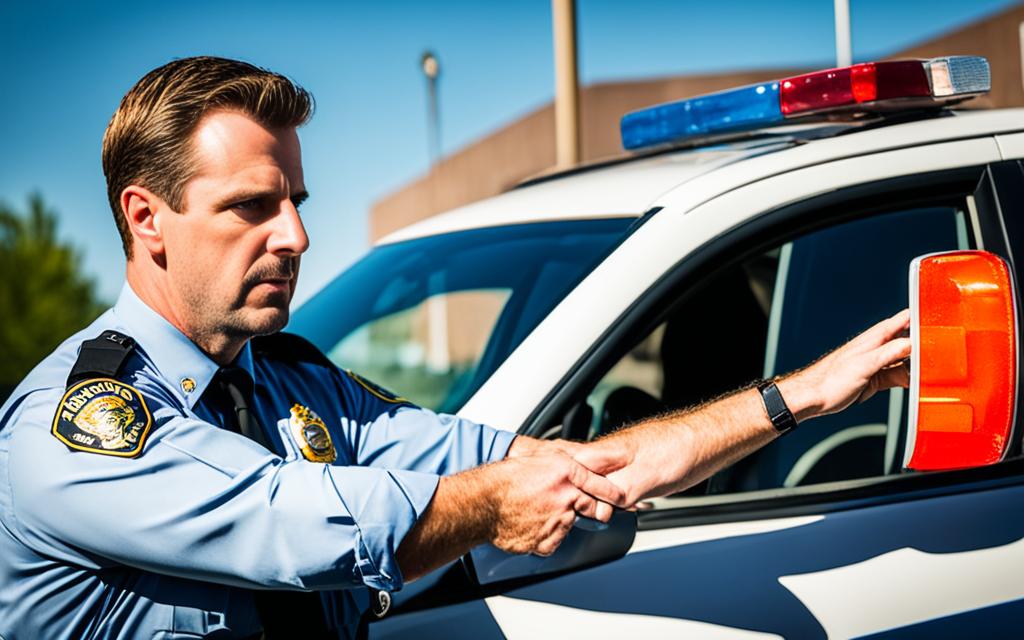
| Benefits of Officer-Driver Interaction | Explanation |
|---|---|
| Improved Communication | Clear communication minimizes misunderstandings and helps drivers understand the reason for the stop. |
| Enhanced Compliance | Establishing rapport encourages drivers to comply with instructions, leading to a smoother traffic stop process. |
| Reduced Tension | A positive interaction reduces tension, promoting a safer environment for both officers and drivers. |
| Increased Mutual Understanding | Officer-driver interaction fosters mutual understanding, leading to greater trust and cooperation. |
Following Traffic Stop Protocols
When you find yourself in a traffic stop situation, it is crucial to understand and follow the established protocols. These procedures not only ensure your safety but also contribute to a smooth and lawful interaction between you and the police officer.
Complying with traffic stop procedures is essential for maintaining legal compliance and promoting a positive outcome. By following police instructions and adhering to standard operating protocols, you can help prevent any misunderstandings or escalations during the encounter.
Understanding Your Rights and Responsibilities
As a driver, it is important to be aware of your rights and responsibilities during a traffic stop. Familiarize yourself with local laws and regulations related to traffic stops, as well as your rights regarding search and seizure. This knowledge empowers you to navigate the situation confidently and assert your rights if necessary.
Additionally, understanding your responsibilities as a driver allows you to cooperate with the officer effectively. This includes providing accurate identification, vehicle registration, and insurance information when requested.
The Role of Communication
Clear communication is key when interacting with a police officer during a traffic stop. Listen attentively to the instructions provided by the officer and respond respectfully. If you have any concerns or questions, it is important to communicate them calmly and politely.
“Effective communication can help alleviate tension and build a rapport between you and the officer,” says Officer Smith, a veteran law enforcement professional. “By following instructions and communicating openly, drivers can play an active role in facilitating a smooth traffic stop.”
The Importance of Compliance
Complying with police instructions is crucial for your safety and the safety of those around you. It demonstrates respect for the officer’s authority and helps establish a cooperative atmosphere. Remember that any resistance or non-compliance can escalate the situation and potentially lead to legal consequences.
Following traffic stop protocols also promotes transparency and reduces the likelihood of misunderstandings. It allows the officer to perform their duties effectively, ensuring the safety of all parties involved.
Traffic Stop Protocol Checklist
| Checklist Item | Description |
|---|---|
| Comply with Officer’s Instructions | Listen carefully and follow all instructions provided by the officer. |
| Provide Identification and Documentation | Hand over your driver’s license, vehicle registration, and insurance information when requested. |
| Communicate Calmly and Respectfully | Speak politely and openly with the officer, expressing any concerns or questions respectfully. |
| Remain Inside Your Vehicle | Unless instructed otherwise, it is generally recommended to stay inside your vehicle during a traffic stop. |
| Cooperate During Vehicle Inspection | If the officer conducts a vehicle inspection, cooperate by turning on lights, opening windows, and unlocking doors as requested. |
By following these traffic stop protocols, you are not only complying with the law but also ensuring a safer and more efficient interaction with the police. Remember, the goal of these protocols is to protect everyone involved and maintain the order on the roads.
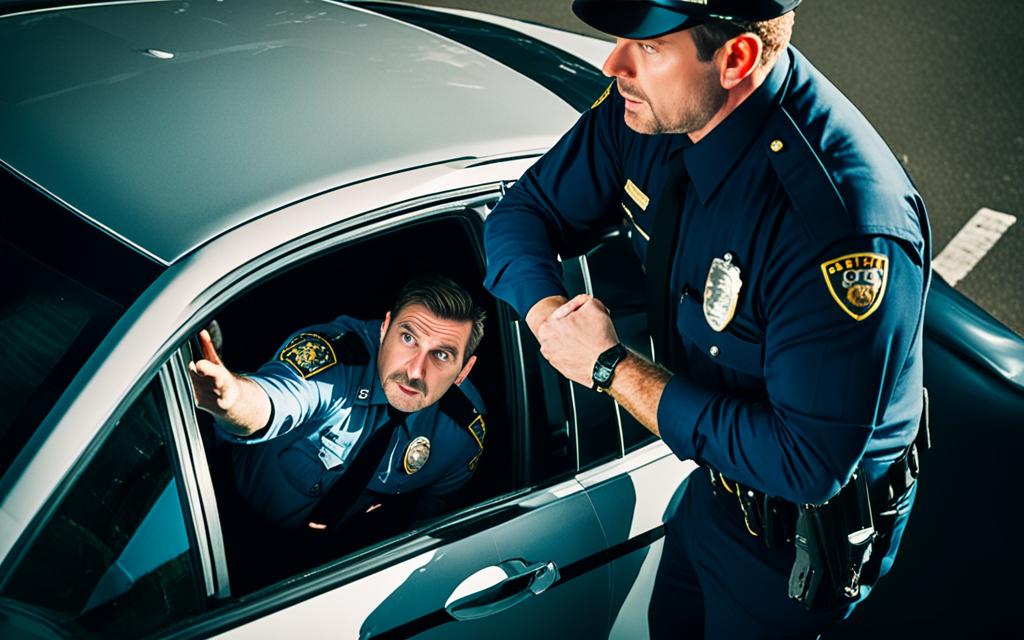
Addressing Concerns of Racial Bias
The practice of racial profiling and biases in policing has prompted concerns about traffic stop disparities. It is vital to address these racial concerns and work towards a more equitable and just system. Ongoing discussions surrounding this issue have highlighted the need for greater awareness and accountability, both within law enforcement agencies and society as a whole.
Racial profiling refers to the targeting of individuals based on their perceived race or ethnicity, rather than evidence of criminal activity. Biases in policing can manifest in various forms, such as disproportionate traffic stops or discriminatory treatment. These disparities have significant implications for the relationships between law enforcement and marginalized communities.
Efforts to minimize racial disparities during traffic stops involve implementing policies and procedures that prioritize fairness and impartiality. This includes providing comprehensive training to police officers on recognizing and overcoming implicit biases. Additionally, collecting and analyzing data on traffic stops can help identify any patterns or trends that may indicate discriminatory practices.
Addressing racial concerns requires a multifaceted approach that involves collaboration between law enforcement, community organizations, and policymakers. Increased transparency, community engagement, and dialogue can foster trust and understanding between police departments and the communities they serve.
| Key Steps in Addressing Racial Concerns | Benefits |
|---|---|
| Implementing anti-bias training for law enforcement personnel | Enhanced awareness and recognition of implicit biases, leading to fairer treatment |
| Collecting and analyzing data on traffic stops by race | Identifying any disparities and potential discriminatory practices |
| Engaging in community outreach and dialogue | Promoting trust, understanding, and collaboration between police departments and communities |
| Ensuring accountability and transparency within law enforcement agencies | Building public confidence and addressing concerns of discriminatory practices |
“We must acknowledge and confront the existence of racial biases within policing. By doing so, we can work towards a system that respects the rights and dignity of all individuals, regardless of their race or ethnicity.” – John Lewis, Civil Rights Leader
We cannot ignore the impact of racial profiling and biases in policing on communities, particularly those that have historically faced systemic discrimination. It is crucial to continue these discussions, push for policy changes, and ensure that law enforcement agencies address these concerns effectively and proactively.
Conclusion
Understanding the reasons why police officers touch your car during traffic stops provides valuable insights into their procedures. This multifaceted practice serves various purposes, including ensuring officer safety, conducting vehicle inspections, and following law enforcement protocols.
By prioritizing officer safety, touching your car allows them to check for any potential risks or threats. It is a precautionary measure aimed at safeguarding both the officer and the public during the encounter.
In addition, vehicle inspections play a vital role in detecting contraband and illegal items that may pose a danger to society. By inspecting the exterior of your car, officers can identify any visible issues that might compromise its safety, ensuring roadworthiness and compliance with regulations.
Overall, comprehending the details of car inspections and understanding police procedures during traffic stops fosters a better understanding and cooperation between law enforcement and the public. This knowledge enables us to appreciate the importance of these practices in maintaining public safety and upholding established protocols. Through ongoing dialogue and awareness, we can work towards a harmonious relationship between law enforcement and the community they serve.
FAQ
Why do cops touch your car?
One reason why cops touch your car is to ensure their own safety during a traffic stop. It is part of the police procedure to conduct a vehicle inspection and identify any potential firearms or contraband. In addition, cops touch your car to inspect the vehicle for any visible issues that might compromise its safety and roadworthiness.
What is the purpose of vehicle inspection during traffic stops?
The purpose of vehicle inspection during traffic stops is to ensure the safety of both the officer and the public. It helps police officers identify any potential firearms or contraband. It also allows them to inspect the vehicle for any visible issues that might compromise its safety, such as broken lights or malfunctioning equipment.
How does officer-driver interaction play a role in traffic stops?
Officer-driver interaction is significant during a traffic stop as it helps establish contact, exchange identification, and maintain effective and respectful communication between both parties. Clear communication and compliance with officer instructions contribute to a smooth and lawful interaction.
What are the protocols for following during a traffic stop?
It is important to comply with traffic stop protocols, which include following police instructions and understanding the rights and responsibilities of both the officer and the driver. These protocols ensure a smooth and lawful interaction, contributing to public safety and effective traffic control.
How can concerns of racial bias be addressed during traffic stops?
Concerns of racial bias during traffic stops can be addressed through ongoing discussions, efforts to minimize racial disparities, and greater awareness and accountability in policing practices. It is crucial to promote equal treatment and unbiased enforcement of traffic laws.
What conclusions can be drawn about cops touching your car during traffic stops?
Understanding the reasons behind cops touching your car during traffic stops reveals the multifaceted nature of this practice. From officer safety to vehicle inspection and law enforcement protocols, it plays a crucial role in ensuring public safety and following established procedures. By exploring these facts, we can foster better understanding and cooperation between law enforcement and the public.

